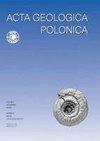Review of the Cretaceous dinosaurs from India and their paleobiogeographic significance
IF 0.9
4区 地球科学
Q3 GEOLOGY
引用次数: 1
Abstract
: Khosla, A. and Lucas, S.G. 2023. Review of the Cretaceous dinosaurs from India and their paleobiogeographic significance. Acta Geologica Polonica , 73 (4), xxx–xxx. Warszawa. The Indian Mesozoic dinosaur record is famous for documenting significant aspects of dinosaur evolution during the Triassic, Jurassic and Cretaceous periods. The Cenomanian–Turonian Nimar Sandstone, Lower Narmada valley, has produced fragmentary skeletal remains of Sauropoda indet. The Maastrichtian Lameta Formation has yielded at least 6 valid sauropod taxa and indeterminate titanosaurid remains, and at least 11 named (but likely oversplit) theropod taxa, i.e., 3 smaller-bodied species and 8 medium-to-large sized theropods. Apart from skeletal remains, Infra-and Intertrappean beds of peninsular India have yielded more than 10,000 dinosaur eggs belonging to 5 oofamilies and 15 oospecies. Most of the Indian ootaxa show distinct affinities with the Late Cretaceous ootaxa of four other continental areas – Spain, France, Argentina and Morocco. The presence of the two dominant oofamilies, Fusioolithidae and Megaloolithidae, in the Infra-and Intertrappean localities of peninsular India and three different continents (South America, Europe and Africa) further shows an ancient Gondwanan affinity and basic terrestrial association among these three landmasses. Based on the phylogenetic analysis of skeletal material, the most plausible pathway of dinosaur dispersal between India and Madagascar took place during the Late Cretaceous. The other conceivable dispersal pathway for the small animals was between India and Asia by means of the Kohistan Dras Volcanic Arc or a northeast pathway through Somalia, while the very large vertebrates, like theropod dinosaurs, may have emerged as a component of a ‘Pan Gondwanan’ model.印度白垩纪恐龙及其古地理意义综述
本文章由计算机程序翻译,如有差异,请以英文原文为准。
求助全文
约1分钟内获得全文
求助全文
来源期刊

Acta Geologica Polonica
地学-地质学
CiteScore
1.70
自引率
18.20%
发文量
0
审稿时长
>12 weeks
期刊介绍:
Acta Geologica Polonica publishes original and review papers on all aspects of basic geology, with particular focus on sedimentology, stratigraphy, palaeontology, regional geology, structural geology, and regional petrography. All papers are published in English.
 求助内容:
求助内容: 应助结果提醒方式:
应助结果提醒方式:


